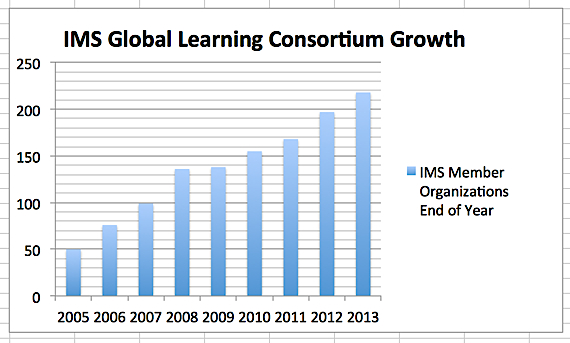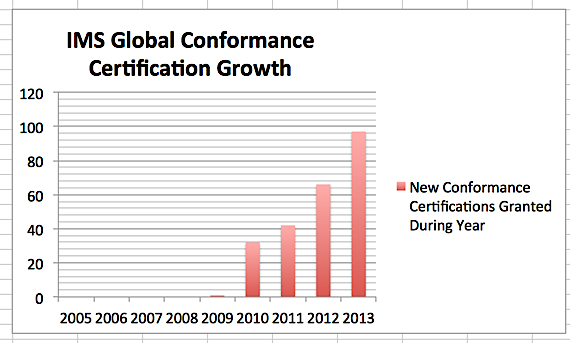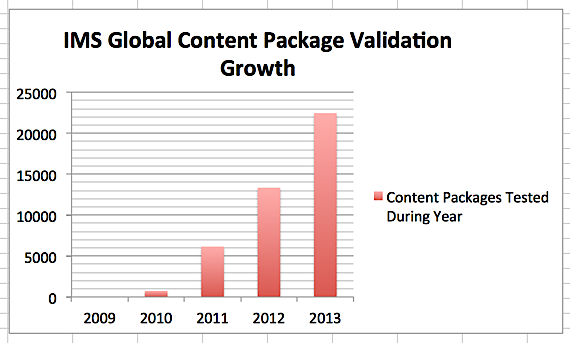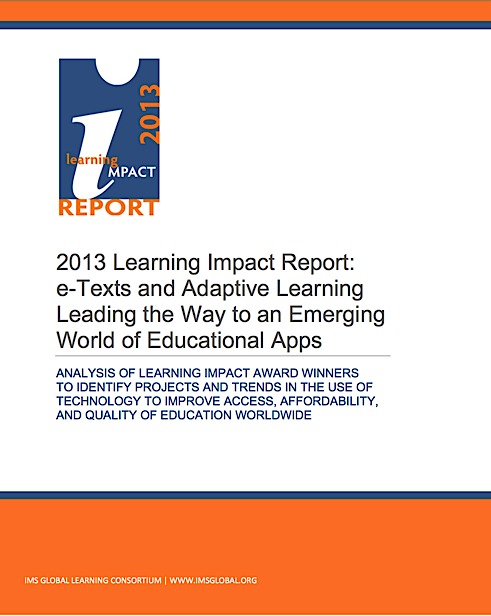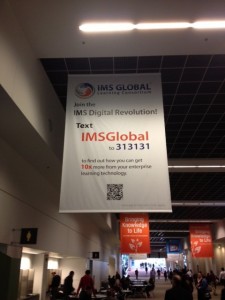At the 2013 Learning Impact conference I presented a keynote “Innovation, Disruption, Revolution – Oh My!” I chose this topic because the degree of hype about “disruption” in education seems to be at an all time high right now. BTW it's amazing how well the Gartner Hype Cycle fits the Wizard of Oz! 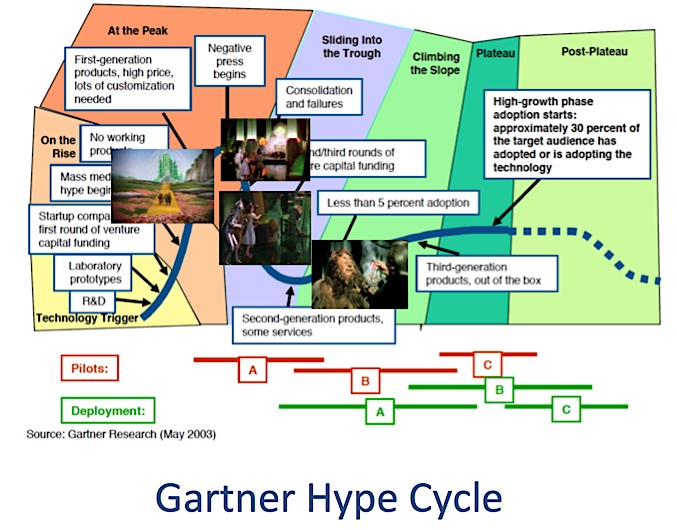
From Rob Abel's Learning Impact Keynote: Innovation, Disruption, Revolution Oh My!
Excitement about the role of technology in improving education is a good thing as far as I’m concerned. Education is a segment that needs disruptive innovation. To me the hype around things like MOOCs represents a longing by many for “a better educational future” – presumably involving lower costs to students and better career/life fulfillment, not to mention better global citizens needed to solve our global challenges. Let’s face it - there is a general sense that the current education system is not up to the challenges of the future. And, it’s not clear how we get from “here” to “there.”
But, as leaders in the education segment we do need to get better at understanding where we have been and where we are going, what constitutes innovation and/or disruption that is worthy of investment? Are you an investor? I would argue that any individual that is putting time into educational technology leadership at any level is an investor, but certainly institutions that are spending on innovation, and yes, venture capital investors (investors in this segment, including some pretty big names, are making some bad decisions right now about where they are putting their money – but this post is more about how institutions should decide to invest their resources).
In 1EdTech we try to ferret out “winners” by looking at criteria for something we call “Learning Impact” – which is defined by a set of judging criteria we use in our annual Learning Impact Awards (LIAs). You can think of it as evidence that the application of technology in an educational setting has had a clear impact on access, affordability and/or quality. We’re pretty proud of this program because there is simply no way to win with hype. But, in general the whole annual Learning Impact event is about understanding where the innovation really is.
Right now there are quite a few over-hyped activities in the education segment. I would include in these MOOCs, Common Core State Standards, analytics, badges and open educational resources (OER). Sorry if I tipped over one of your sacred cows there! Over-hyped does not mean that something good will not come from these developments. It just means that they are being portrayed as more significant in terms of ability to “disrupt” education than they will be capable of delivering on. As with most hyped innovations, eventually some aspects of the innovation “survive,” crossing the chasm to productive advancement of the industry. The challenge for innovators and investors is to utilize critical thinking to rationalize what will sustain and what the real Impact will be.
MOOCs are perhaps everyone’s favorite example of hype right now. It’s difficult to imagine how something could have achieved more hype in the higher education segment – and they are very clearly striking a nerve for being potentially highly disruptive. Literally every day MOOCs are in the headlines – and smart marketers are trying to jump on the MOOC bandwagon even as that bandwagon morphs continually to address the glaring deficits of the MOOC model and quite frankly, more failures than successes at this point.
Clayton Christensen, the leading expert on “disruptive innovation,” has written at least two books specifically focused on education. According to Christensen’s disruptive innovation theory markets are disrupted when new entrants figure out an innovative way to provide a “simpler” product to a wider set of buyers at a more affordable price. Since the simpler product is actually what the broader market prefers (simpler means more usable, more effective for the desired purposes) the product is highly disruptive – better product at lower price point. And thus, these new entrants change the market behavior substantially. Jim Farmer does a very thorough job of digging into the theories as applied to MOOCs here.
While I, like many other silicon valley entrepreneurs, have found Christensen’s original formulations on disruptive innovation descriptive of what is generally seen in the high tech world, and a useful thought framework, well, the problem is that these formulations have not been at all predictive for education – and that is the acid test for using theory for strategic gain – is it predictive? Writing about what happened in the past and putting a framework around it is great – but if it doesn't help predict the future it doesn’t especially help entrepreneurs or us “investors.”
The innovators in the education segment have NOT disrupted the status quo significantly so far. While Christensen predicted in 2008’s Disrupting Class great disruptions in the segment from online learning, the reality so far is that greater adoption of online learning has continued as expected but not very disruptive: price points for education continue to rise ahead of inflation and while online education continues to grow it is largely seen as reflecting traditional models rather than a disruption. And, while online/blended models have certainly improved access – well, the percentage of the population that has achieved credentials has been very level. I wrote a paper about what the technology impact in higher education back in 2005-7 - and the situation is not significantly different today.
Christensen was recently quoted in an interview as stating that higher education institutions are going to be in real trouble 5 years from now. However, he has not made it clear why things will be different in the next 5 years versus the last 5 years since Disrupting Class was published. I do agree that “buyers” (students/parents) are in fact getting smarter about looking for lower cost options as well as attempting to understand the value of a higher education degree. But I would argue that we are nowhere near a true disruption (rise) in the number of participants in higher education.
While it is very valuable to have any great thinker on business strategy analyzing education and providing insights from other industries that might apply (like Christensen), education leaders need to do their own critical thinking about these formulations of “disruptive innovation” in the education segment.
I’d like to provide three key factors that IMHO are needed to be understood if to understand disruption in education. While these factors may be relevant to understanding MOOCs, they can be applied to other hype areas as well. Hold on to your hat here as these are things that we don’t hear much talk about in the education space – especially when you go to meetings on one of the hyped topics or even to investor conferences!
- Education is a complex services business in which quality is difficult to define. Disruption in the education space requires better service models that are built around improved educational program quality. Comparison of education to the disruption of the steel industry by mini-mills (a connection some have made because Christensen uses this as a classic example of disruption) is not a valid comparison. Disruption in education is not about replacing the low end of a well-defined product. It’s about redefining quality in a much more complex world of knowledge than that from which most current educational models were designed. So, for instance, a true disruption in education would be highly desirable/effective K-masters degree in 15-16 years versus the current 19 years (ideally that meets the needs of under performing populations as well as traditionally successful populations).
- The next phase of true progress will be to come out of the current era of massification into a new era of more real world relevant and personalized educational pathways. Massification of educational experiences will not be the ticket to success in the next wave of educational models. It seems that many of the entrepreneurs and investors in the education space fail to realize that we have already been in the era of massification of education for the last 30 years or so in developed countries. The disruption in terms of content will need to be content that enables educational experiences that are up-to-date (read “relevant”), adaptive to the interests of the learner, easily adaptable by teachers and yet thorough in terms of teaching the educational foundation that are defined via #1. No offense to our friends at Coursera (one of the growing number of MOOC providers), but “course era” is an especially off the mark name for describing the future IMHO. It is NOT a course era now in education nor will it be in the future. It is the same era that it has been: which is one in which a distinctive program of high quality education will be highly valued. It's just that we need to do a better job getting such distinctive programs to the currently underserved populations at a better price point. Yes, there will be different sources of supporting digital resources that will help enable the redesign of educational delivery (potentially a role for MOOC courses). As discussed in other LI blog posts (here & here) digital resources will need to be in a form of a highly usable toolkit for faculty and learners. But, these supporting resources have a VERY long way to go to meet the needs of learners. And, the more available (i.e. free, open, massive, etc) a course or content becomes the faster it will become commoditized.
- Education is the ultimate “long tail” market with a growing proliferation of high value niche providers and boutique programs. This is only going to increase in the future. Contrary to other recent online phenomena like facebook or twitter, education is not a “winner take all” market. I was at an education investor conference earlier this year where a leading investment advisor made the statement that education is the “ultimate winner take all market.” Education, if done correctly, is life success enabling. The more unique and distinctive your educational experience is, the more valuable it is. The ability to produce knowledge is the key currency in the current and future global economy. There is no distinctiveness to attending “Massified University.” And, a credential from a massive provider will most likely be such a commodity that most will prefer not to waste their time on it (other than for pure fun or reference). We need many more niche-oriented institutions that provide specialized, career-enabling and life-enabling education. Note that even large public institutions, while having many students, can engage this philosophy to create a large number of differentiated programs of study. Therefore, the “disruptive technology platforms” for education will need to enable great diversity. Diversity in terms of delivery models and blending of high touch with personalized self-service. Disruptive platforms will also need to enable seamless integration among cooperating providers of the various components of a solution – meaning close partnership among institutions as well as innovative learning tools. Old style Web 2.0 thinking of the single pervasive platform or the single way of analyzing data will not work for the future of education. Education is not that simple (sorry!).
Are MOOCs potentially promising innovations? Yes. They are clearly an evolution of the trend toward pervasive online/blended/more flexible educational models/flipping the classroom. Will they disrupt education? Not on the current trajectory. They pretty much fly in the face of the three tenants above.
But, there are some potential ways in which MOOCs could be disruptive in a more limited way.
I think MOOCs have the potential to be disruptive on the low end of the education market as a new model for delivering “open university style education.” For example, today’s MOOCs could be an appealing alternative to the content portion of massive open universities around the world, featuring star professors from highly ranked universities. And, such populations of learners could probably support an advertising/low course fee model of consumption. So, open university providers get a “pay per use” version of content (versus the larger investments they must make today for tuition) that is likely better than what they are offering today, which if subsidized by advertising (net revenue equals small pay per use from open university provider coupled with advertising revenues) could equate to substantial revenues over a large numbers of users with similar interests (as indicated by the topic of study).
In such a model MOOCs could also double as a new type of “tutorial” reference materials. Very much like Kahn Academy, which is often referred to as a MOOC now even though it existed for a few years prior to the term.
Would this application of MOOCs be disruptive? Well, if you consider displacement of open universities and/or a new business model for them disruptive, then yes. This approach could potentially disrupt the open university market worldwide and create a much larger interest in open university derivative models as a way to learn more about a particular topic and/or as preparation for entry to other universities. Will they substitute for those universities – no. Such a disruption will not radically change the efficiency of higher education segment at all.
Is there a strong motivation for current providers of education to engage in this model? Unclear. As previously discussed the more you commoditize an educational experience the less valuable the education is. As discussed above the next stage in education is greater diversification, not massification. Personally I would like to see existing institutions respond to the three factors above by rolling out new “institutes” with new types of degree programs that meet the evolving needs of society.
Should open universities or other new entrants that wish to compete in that space try a MOOC/advertising/low course fee supported model? I hope so. That would be a good fit with the “course-focused” strength of MOOCs. It would also provide a potential revenue producing and marketing outlet for institutions and their “star teachers.” Of course there are the normal challenges of achieving accreditation from the countries/states as needed to prove value to the potential students.
So, hooray for the MOOC phenomena in terms of making claims about needed innovations such as scale, analytics and the potential power of star teachers that will help accelerate the innovation trend toward online/blended that we are already on! And, congratulations to the leading institutions willing to make a space to try out the MOOC innovations as another set of tools that might be leveraged in the quest for improved education.
However, I would say that if you don’t know at this point why you are investing (in terms of what impact you expect will sustain at your institution, and therefore what the return on your investment is likely to be) then you are not applying the level of critical thinking you need to. Personally I would be asking MOOC providers to take the risk in terms of proving the validity of the market/business model (such as the ideas around open university displacement) – and not taking on that risk for my university.
[Note: In a future blog post I will take a whack at what I think will be the sustainable innovations that might cross the chasm coming out of some of the hype items mentioned above: MOOCs, Common Core State Standards, analytics, badges and open educational resources (OER).]
See more of Rob Abel’s views on educational innovation throughout the Learning Impact blog as well as this feature interview with Anthony Salcito of Microsoft.






